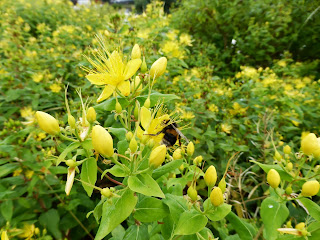FOLK
REMEDIES …
Sometimes the oldies are the best (and cheapest!) .. so I thought
I would start putting a few 'Home Remedies’ in this Blog. If you know of any easy and simple home remedies,
please let me know and I will pop it in the next Blog post to share with
everyone.
In the meantime, here is a recipe for a decongestant syrup,
a remedy to ease heartburn and also a remedy for acne - all containing the wonderful Manuka
Honey …
Manuka
Honey
You may have heard of Manuka Honey - it is a premium
medical-grade honey, produced by bees that gather nectar from the flowers
that grow on the Manuka bush (also known as Leptospermum scoparium) which is
indigenous to New Zealand
and certain parts of Australia.
Studies have found that Manuka Honey contains very powerful
antibacterial, antimicrobial, antiviral, antioxidant, antiseptic, anti-inflammatory
and anti-fungal properties, making it extremely effective in treating a wide
variety of health conditions.
There are so many therapeutic uses for Manuka honey but one which always gets a lot of 'airplay' is the use to help leg ulcers, for which you can even buy Manuka coated dressings. You can google and get loads of info. on this use but I thought I would just share one link here that may be of particular interest to animal owners as it has loads of info on the use of honey but also its use on animals
... click here to read all about it!
There are so many therapeutic uses for Manuka honey but one which always gets a lot of 'airplay' is the use to help leg ulcers, for which you can even buy Manuka coated dressings. You can google and get loads of info. on this use but I thought I would just share one link here that may be of particular interest to animal owners as it has loads of info on the use of honey but also its use on animals
... click here to read all about it!
Most standard honeys contain hydrogen peroxide which is a
known antiseptic but Manuka Honey is significantly different in that it has additional
antibacterial properties that have the ability to destroy the infectious
bacteria that cause most health complications. Unlike standard honey, Manuka
Honey is also stable so there is no concern of it losing its potency or healing
properties.
Among its many, many uses, Manuka Honey can be taken for GASTRO INTESTINAL DISORDERS
ranging from Acid Reflux to Irritable Bowel Syndrome – one example of this use
is for …Acid Reflux and Heartburn
All you need to do is ...
Take 1 teaspoon of Manuka Honey 3-4 times per day on a small
square inch size piece of bread or toast, 20 minutes before meals, to coat the oesophagus. How easy is that?!
Manuka Honey also has applications for SEVERE ACNE …
After washing your face with warm water, apply a thin layer
of Manuka Honey all over the face and leave it on for 15 minutes.
If possible, do this while in the bath while also enjoying the steam from the bath water.
If possible, do this while in the bath while also enjoying the steam from the bath water.
Wash off the honey with warm water after 15 mins and then
with a (pre-prepared) cut lemon slice gently wipe this over the area, then wash
off with warm water again and gently pat dry.
It is also brilliant to help the respiratory system - here is a remedy for ...
DECONGESTANT
SYRUP – ONION-HONEY
Ingredients:
¼ onion, chopped finely and 3 tablespoons Manuka honey
Method:
Place the onion in a bowl and pour over the honey. Leave to stand
over night.
Dosage:
Take one teaspoon of the honey, three times a day.
This may be continued for up to one week.
Benefits:
Clears mucus and congestion. A great for remedy for children as they enjoy the sweetness.
I hope you enjoy these little remedies ! Til next time ... El x'
This may be continued for up to one week.
Benefits:
Clears mucus and congestion. A great for remedy for children as they enjoy the sweetness.
I hope you enjoy these little remedies ! Til next time ... El x'








































